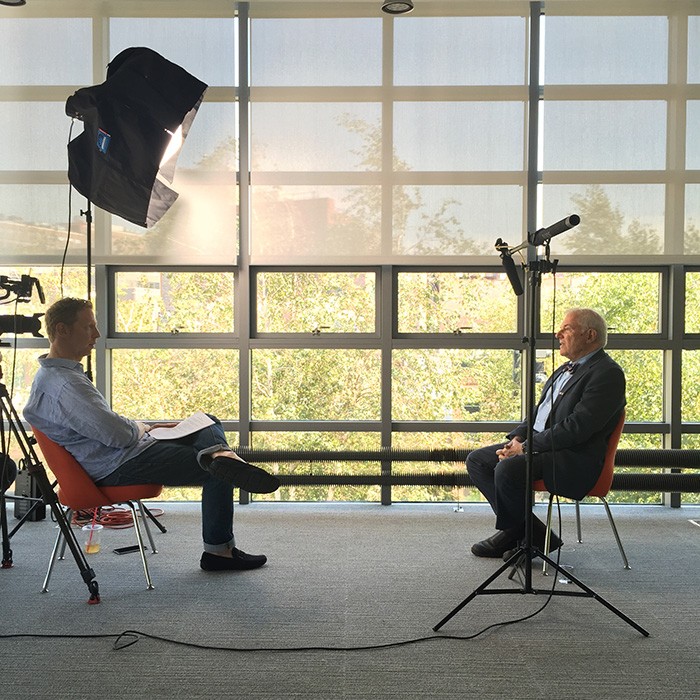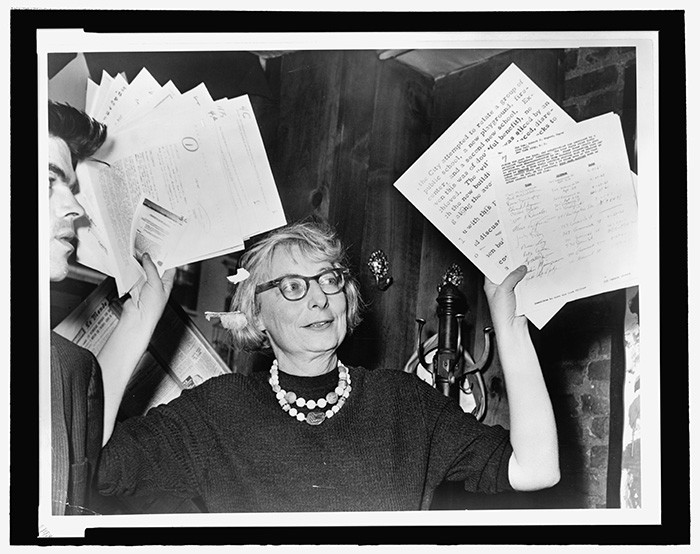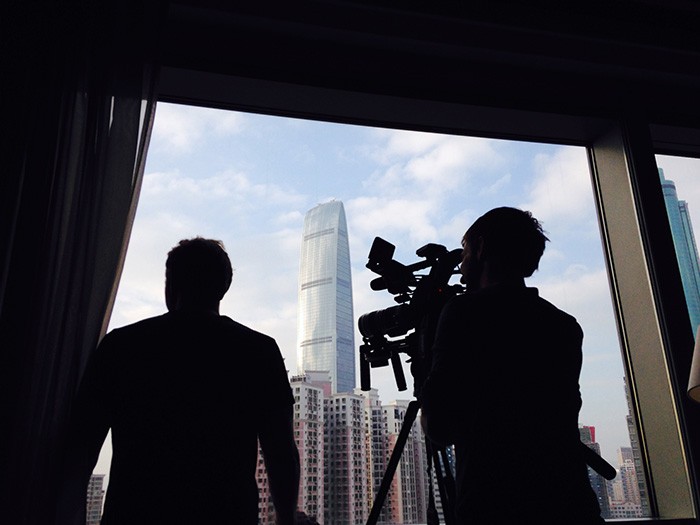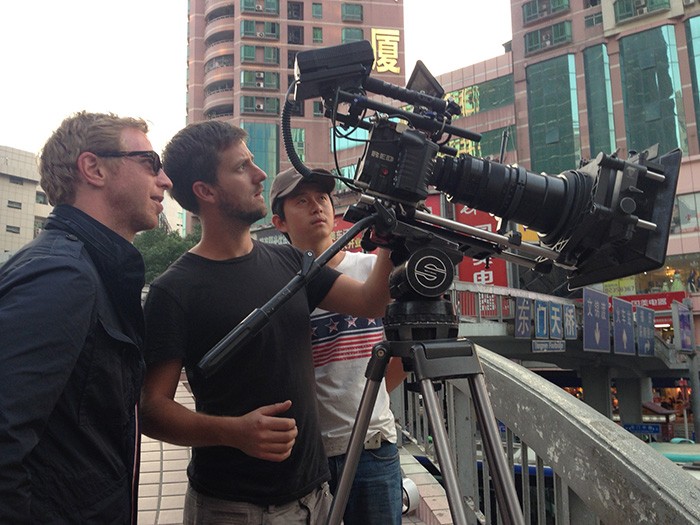
Debuting at the Toronto International Film Festival in 2016, Matt Tyrnauer‘s Citizen Jane: Battle for the City has received rave reviews across the country as it opened in limited release last month. Centering on Jane Jacobs — a journalist, author, and activist — the film showcases the problems inherent to how urban planners in the mid-twentieth century worked.
One of the key proponents of this movement to teardown what he deemed “slums” for new, mammoth housing projects of concrete erasing the very communities they sought to “save” was New York’s Robert Moses. His power and reputation allowed him to force his ideas through the legislature for decades until Jacobs caught wind professionally and personally (he would eventually target her neighborhood). She ignited to take a stand and share her own beliefs in writing and via protest on city living, safety via “eyes on the street,” and the notion that cities are defined by its people, not its buildings.
We spoke with director Tyrnauer about his project’s origins, Jacobs as intellectual and activist, and her continuing impact today.
The Film Stage: I’m sure you get this question every interview, but when did Jane Jacobs get on your radar as a documentary topic?
Matt Tyrnauer: I read [her book] The Death and Life of Great American Cities about six years ago. So I came late to it. I’m not schooled in urban planning or architecture, but I’ve written about architecture — mostly for Vanity Fair magazine and sometimes the New York Times. But I had never read The Death and Life of Great American Cities.
I bought it at a bookstore not far from where Jane Jacobs lived — in the Village [Grennwich Village in New York City]. [It was] one of those books I had always intended to read, but never had. And I was immediately taken with it: her writing style and the way she makes you see the city in a completely different way than you had seen it before.
Then I was talking with friends about the book. Among them was Robert Hammond who co-created the High Line in New York [and helped produce Citizen Jane]. We started almost joking: “There should be a Jane Jacobs documentary.” There’s never really been one that’s theatrical. And that’s how we got started.

Did the project start as a straight biography about her life before paring down to this specific focus. Or was that always the intent?
No. Actually we started farther away from biography then we ended up. We wanted to make a movie about ideas.
The movie was mostly foundation funded. The Rockefeller and Ford Foundations are the principal funders and they were very interested in a film about Jane Jacobs as she relates to the current day’s issues of cities — as were we. So we started off more in that direction and then put more biography in … although I never intended to make a biographical portrait of Jane. I wanted to make a movie about her ideas.
In the name of making a movie that was accessible to as broad an audience as possible, [we were led towards] a film that was about her ideas but also a particular period in her history when she was writing The Death and Life of Great American Cities — her first book — and also her pivoting into activism and taking on Robert Moses in New York City. And in many cases winning her battles with him.
What was the researching process like? Your first film [Valentino: The Last Emperor] allowed you to have access to your subject — they were alive for you to follow around. What was it like to transition into a completely archival film?
Well, I’m a big vérité guy. So I love vérité filmmaking — my next film is a vérité film. But I also wanted to try my hand in an archival movie. I’m a huge admirer of modern architecture and am obsessed with cities, so it’s subject matter that I’m deeply interested in. So it seemed like a good idea to do something archival, especially in an area where I’m so keenly interested.
So I really was excited to be able to look at all the archival photography of the cities — particularly in that period of the early to mid-twentieth century. Cities were so beautiful then and the photography of them is so evocative. I was also excited to go on the hunt for rare footage of Jacobs and Moses. We succeeded, eventually, in finding never-before-seen footage.
So it’s definitely flexing a different set of muscles — doing an all-archival film — but it was a challenge I was eager to take on.

What was your process as far as finding the subjects you interview about Jacobs and her work? Did you seek people who knew her or search out those who appreciated her ideas?
There’s a range. Some people knew her and are involved in the issues of city planning — and in some cases architecture. And then there are a lot of scholars who wrote very well on her. So we talked to people and found those we thought would be the best and most articulate on-camera.
The film has no narrator so we really lived or died by what our interview subjects said. There’s nothing like a great interview — someone who can really sell what they’re talking about. That’s hugely important to a film like this.
You self-distributed Valentino, but this one is of course being handled by Sundance Selects. Can you talk about that experience and how it prepared you for readying this film on those terms?
Yeah. Self-distributing Valentino was a great — and I might say unexpected — education because we didn’t initially plan to self-distribute it. But it ended up that way and I wouldn’t trade it for anything. It was an amazing experience. I learned so much about how the distribution side works and that’s information that a lot of filmmakers don’t get.
It turned out that Valentino was extremely successful on self-distribution. I think Box Office Mojo has it just under two million, but it’s actually over two million due to inadequacies of its accounting procedures. But anyway, it did — for a doc, as you know … it was really, really high for just theatrical. So it turned out to be a positive experience if a daunting one.
But it did, I think, help a lot with engaging our distributor. I think it allowed me to understand where the strengths and weaknesses of our movie lie and how to best support it as the distributor brought it out into the world. And also how — you have to be the squeaky wheel sometimes to get your way. Me having self-distributed told me what battles were worth fighting. That was an interesting thing I think I learned.
One of my favorite parts of Citizen Jane: you’re telling this great story that many people may not know, but underneath it is Jacobs’ activism and its parallels to today. She’s — as revealed in your movie — a precursor of sorts to the Women’s Marches and a lot of the stuff happening right now. Can you talk about balancing those two aspects?
Jacobs’ brilliance is sort of in two parts. She’s a brilliant writer and thinker and synthesizer. The Death and Life of Great American Cities goes down as perhaps the greatest book ever written about cities, but also maybe one of the greatest books of the twentieth century — it’s never been out-of-print. It’s one of the few books that you can say changed an entire profession. Urban planning was never the same after that book. It created a paradigm shift.
The other part of Jacobs is that she was a great activist and strategist in that realm. So these were the two parts of her story that we needed to tell.
When we started out making the film, we never could have predicted a Trump presidency. As we were finishing the film we were anticipating our first woman president. So we thought the film would be received with that as a historical backdrop. Well we were of course very wrong about that. The story of Jacobs’ activism and the success she had against tremendous odds resonates in an entirely different way. I think it’s one of the film’s strengths.
If you had asked me when we started the project what the big take away would be, I would have said, “Well, it’s how important cities are in our century.” That’s the number one topic because it’s adjacent to [today’s] most important things: climate change, sustainability, poverty, and hunger. For all these things a city matters. But given the urgency of the political crisis that’s sweeping — not only our country, but also the world right now — [it becomes] a playbook for activism and an example of someone who was effective in defending minority communities. I think this is very urgently needed and I’m very pleased the film is resonating in that way for a lot of audiences.

And in that same climate we’ve been receiving a lot of dystopian views in art again. Looking at the designs you included in the movie with Corbusier as an example, I couldn’t stop being reminded of Terry Gilliam’s Brazil or J.G. Ballard’s High-Rise.
Oh, I love that comparison. I’m a Los Angeles native. I lived in New York for quite some time, but I’m now back in LA. So Blade Runner is a touchstone. They got it so right in its fantastic way.
I actually went to see — this is a side-note — the man who invented that world for Ridley Scott. I’m blanking on his name right now. Do you know whom I mean? He’s a futurist.
I can’t think of it.
I’ll have to look him up. [The artist in question is Syd Mead.] He was the one who kind of sketched out that world. He was at a conference about the future of the city at the Getty Center and was just such a wonderful presence at that event.
Back to the subject at-hand: I think Corbusier … the problem with Corbusier is that he just wasn’t thinking at the human scale. So when urban renewal began to gather steam in the United States and many other parts of the world, this obsession with gigantism and super blocks and super scale was so sexy to architects and planners who could get rich off of it. [They] were blinded by their utopian visions. And when these were realized, Jacobs was among the first to say, “Wait a minute. These things are completely out of scale and are creating many more problems than they are solving.” This is one of her great contributions to society.
It seems so obvious to look at in hindsight. And it’s great to learn that she didn’t go to college for that expertise. She didn’t experience it academically, but lived it instead. That’s a great source of inspiration.
Yeah. That’s very important. She tells you by her example that you don’t need a higher degree to make worthy observations and to put your ideas out there. She was scorned because of her lack of credentials and she continuously — all through her writing, starting with Death and Life — railed against the system of credentialing. It’s almost like a fetish of hers and you can see why.
She’s self-taught. She’s obviously very bright if not even a visionary. She was an incredible observer and intellect and was able to kind of put these things together and arrive at what’s now accepted as common wisdom. But she arrived there generations before the rest of the world caught up.

As kind of an aside — I’m in Buffalo, NY and recently we’ve seen our Robert Moses Parkway in Niagara Falls changes its name to the Niagara Scenic Parkway. Governor Cuomo did it last year and even passed a forty million dollar budget to turn part of it back into park.
Oh wow. I didn’t know about that one. It’s interesting because Cuomo is also trying to take the Sheridan Expressway [in the Bronx] and turn it into a park. It was another of Moses’ pet projects.
I’m sure the success of the High Line is helping him turn things back.
It’s great. This is happening … it’s happening in LA. It’s happening in New Haven — the Oak Street Connector, which destroyed most of downtown New Haven is being taken down, I think. Stuff is happening generations after Jacobs sounded the alarm.
You had mentioned your next project as being another vérité film. Are there any details that you’re willing to share?
Yeah. It’s called Scotty and the Secret History of Hollywood and it’s about Scotty Bowers as the “male madam” to the stars in the Golden Age of Hollywood. He’s still alive and it’s a vérité film about him and about sexuality and Hollywood and America.
Citizen Jane: Battle for the City is now in limited release.

